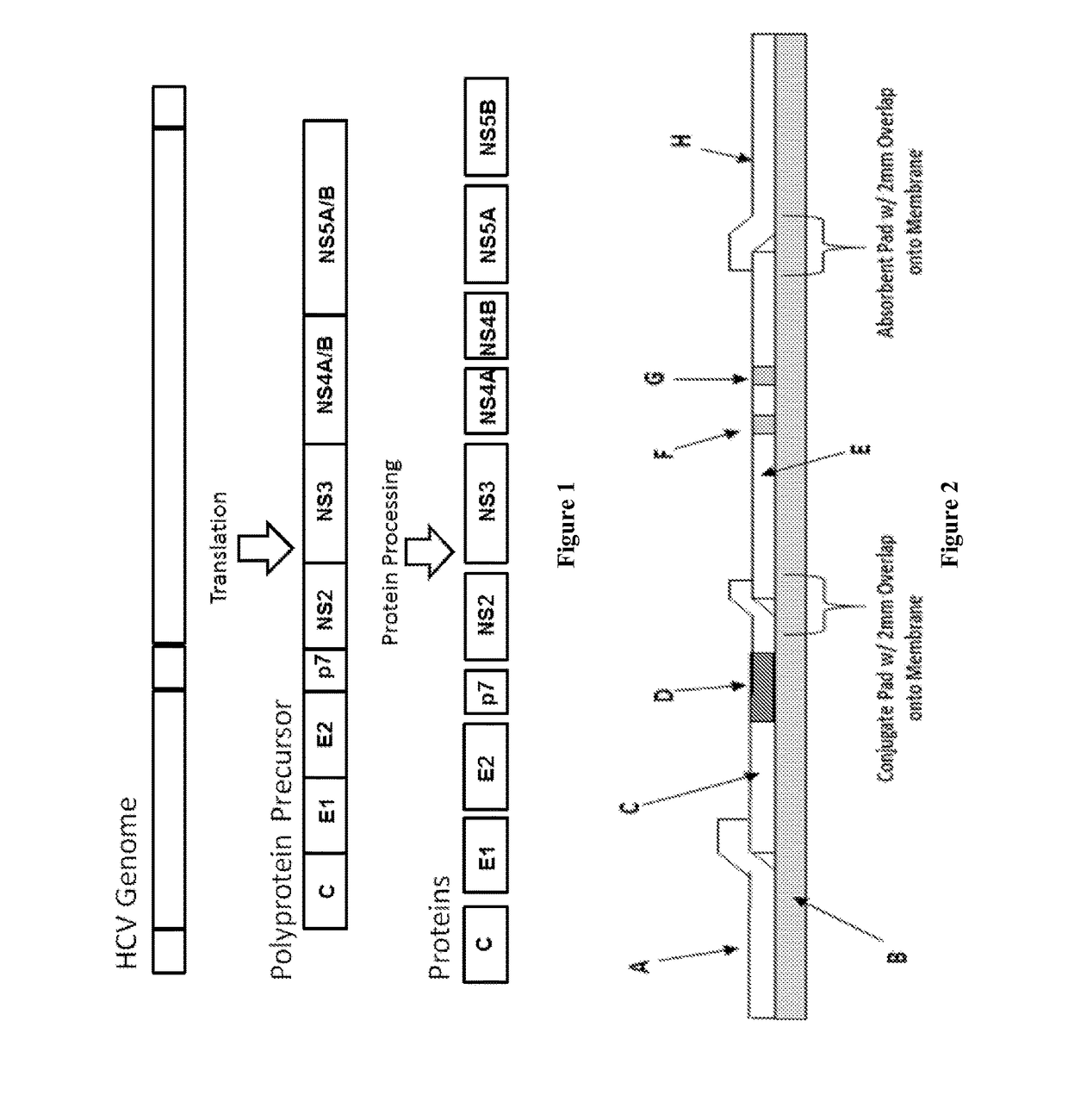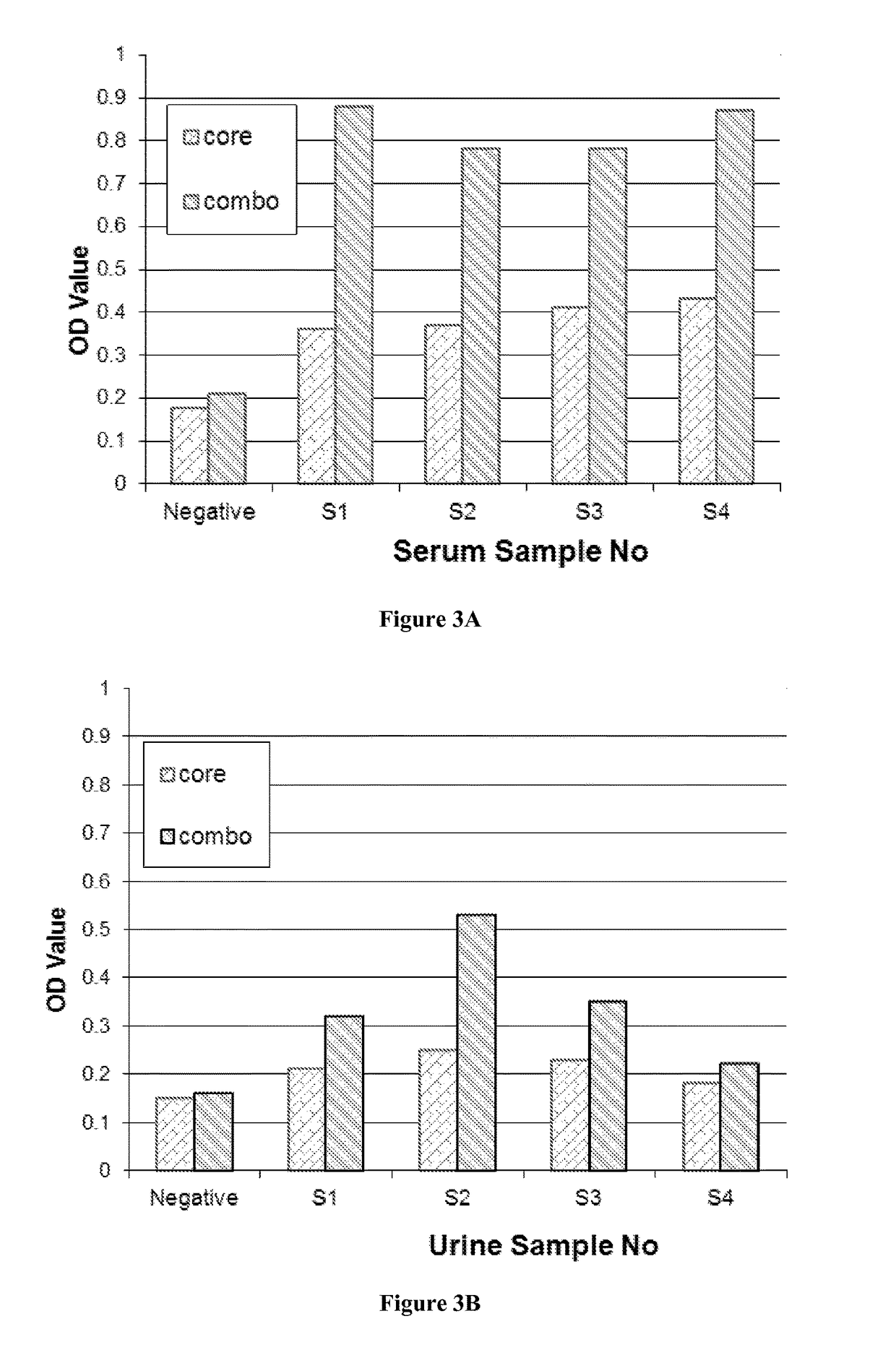Combo-Hepatitis Antigen Assays and Kits for Detection of Active Hepatitis Virus Infections
a technology of hcv and kit, which is applied in the field can solve the problems of delayed access to medical follow-up and effective treatment in many subjects, anti-hcv antibody tests that require time for an immune response, and cannot be used for acute hcv infections. , to achieve the effect of improving the sensitivity of combo-hcv-ags lft assays
- Summary
- Abstract
- Description
- Claims
- Application Information
AI Technical Summary
Benefits of technology
Problems solved by technology
Method used
Image
Examples
example 1
CR
[0073]As disclosed herein, the presence of serum HCV RNA was assayed using polymerase chain reaction (PCR) methods known in the art. Specifically, serum HCV RNA was quantitated by real-time polymerase chain reaction (PCR) using Roche COBAS® AmpliPrep / COBAS® TaqMan® HCV assay, which has a lower detection limit of 43 IU / mL and quantitative limit of 100 IU / mL (Roche Molecular Diagnostics, Pleasanton, Calif.); or using Abbott RealTime HCV assay, which has both lower detection limit and quantitative limit of 12 IU / mL (Abbott Laboratories, Abbott Park, Ill.).
example 2
col
[0074]The following protocol was used in the EIA experiments disclosed herein unless indicated otherwise.
[0075]Step 1. Coating of the Assay Substrate. A 96-well PVC microtiter plate was used as the assay substrate, however, other substrates, e.g., assay beads, known in the art may be used. Each test well of the microtiter plate was coated with a sufficient amount, 50-200 μL, e.g., about 100 μL, of capture antibodies diluted with carbonate / bicarbonate buffer (pH about 7.0-9.5, e.g., about 9.0). The capture antibodies were mixture of monoclonal antibodies against HCVcAg-1 (about 5-20 μg / mL, e.g., about 10 μg / mL), HCVcAg-2 (about 5-20 μg / mL, e.g., about 10 μg / mL), NS3 (about 5-20 μg / mL, e.g., about 5 μg / mL), NS4b (about 5-20 μg / mL, e.g., about 5 μg / mL), and NS5a (about 5-20 μg / mL, e.g., about 5 μg / mL).
[0076]Step 2. Incubation. The microtiter plate from Step 1 was covered and incubated at 4° C. for overnight (or 37° C. for about 15-120 minutes, e.g., about 60 minutes).
[0077]Step 3. W...
example 3
col
A. Test Strips
[0088]As shown in FIG. 2, the LFT test strips exemplified in the experiments herein comprise the following components: A=Sample Pad, B=Backing card, C=Conjugate pad, D=Capture antibody conjugated with colloid gold particles, E=Nitrocellulose membrane, F=Test line, G=Control line, H=Absorbent pad. The test strips were constructed as follows unless indicated otherwise. However, other test strips, dipsticks, etc. known in the art may be used in accordance with the present invention. Thus, the term “test strips” is herein to generically refer to assay substrates, used for LFT assays, having sample pad where a test sample is loaded and then flows through a test line and a control line as having capture antibodies as described below. Although the LFT experiments herein exemplify the use of a colloid gold labeling system, other labeling systems known in the art may be used.
[0089]Step 1. Colloid Gold Conjugation of the Detector Antibodies. The pH value of the colloid gold s...
PUM
| Property | Measurement | Unit |
|---|---|---|
| concentration | aaaaa | aaaaa |
| concentration | aaaaa | aaaaa |
| total volume | aaaaa | aaaaa |
Abstract
Description
Claims
Application Information
 Login to View More
Login to View More - R&D
- Intellectual Property
- Life Sciences
- Materials
- Tech Scout
- Unparalleled Data Quality
- Higher Quality Content
- 60% Fewer Hallucinations
Browse by: Latest US Patents, China's latest patents, Technical Efficacy Thesaurus, Application Domain, Technology Topic, Popular Technical Reports.
© 2025 PatSnap. All rights reserved.Legal|Privacy policy|Modern Slavery Act Transparency Statement|Sitemap|About US| Contact US: help@patsnap.com



